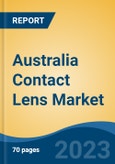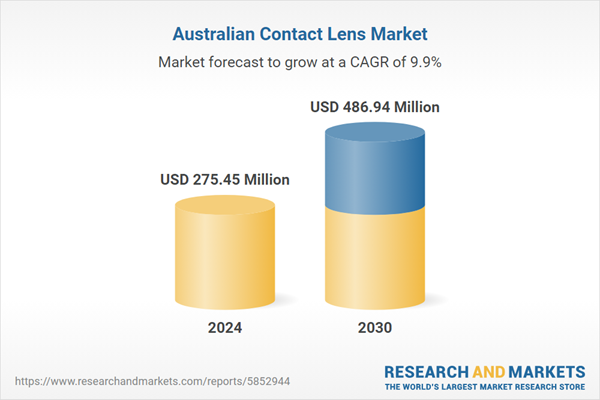Speak directly to the analyst to clarify any post sales queries you may have.
10% Free customizationThis report comes with 10% free customization, enabling you to add data that meets your specific business needs.
With a well-developed healthcare system and broad access to optometric services, the market is witnessing rising demand for daily-use, cosmetic, and specialty lenses. Consumers are gravitating toward products that offer comfort, aesthetic appeal, and convenience, supported by advancements in lens materials and designs. The growing popularity of digital health tools and personalized vision care solutions further enhances the market’s momentum. As more Australians seek flexible and non-intrusive vision correction options, the contact lens segment is becoming a core part of both clinical and lifestyle-oriented eye care strategies.
Key Market Drivers
Rising Prevalence of Refractive Errors and Myopia
A growing number of Australians are affected by refractive errors, with myopia emerging as a dominant condition, particularly among children and young adults. Around 20% of the population currently experiences myopia, and projections indicate that nearly half of all Australians could be impacted by 2050. This trend is largely attributed to prolonged screen exposure and reduced time spent outdoors.Research from Western Australia reveals that myopia rates increased significantly during early adulthood, highlighting the need for long-term vision management. Parents and healthcare providers are increasingly turning to myopia control lenses such as MiSight 1 day and NaturalVue Multifocal to slow disease progression in younger patients. This pediatric segment represents a rapidly expanding demographic for the contact lens market. The combination of earlier onset and heightened awareness of myopia-related risks is driving consistent demand for tailored corrective solutions, making refractive error management a key force behind market expansion.
Key Market Challenges
High Cost of Premium Lenses and Limited Insurance Coverage
A major obstacle to wider contact lens adoption in Australia is the high cost of premium and specialty products. Lenses featuring advanced attributes - such as blue light filtration, higher oxygen permeability, or specialized myopia control - often carry price tags that are unaffordable for certain consumer groups, including students, retirees, and low-income households. While some private health insurance plans offer optical benefits, reimbursement is frequently limited, and cosmetic lens categories are often excluded. As a result, many consumers opt for more economical alternatives or restrict usage to occasional wear. These financial limitations pose challenges for sustained market penetration and slow adoption of technologically advanced lenses that would otherwise improve patient outcomes.Key Market Trends
Rising Adoption of Daily Disposable and Premium Lenses
Australian consumers are showing a strong preference for daily disposable and high-performance lenses, driven by concerns over hygiene and advances in comfort-enhancing technologies. Daily disposables are favored for their ease of use, elimination of cleaning routines, and reduced risk of infection - factors that gained heightened importance during the COVID-19 pandemic. The demand for lenses that provide blue light protection, UV filtering, and enhanced moisture retention is also on the rise, particularly among users of digital devices and those with dry eye symptoms. Leading brands such as ACUVUE OASYS MAX 1-Day and TOTAL30 are gaining market share by offering these benefits. This shift is reinforcing the premiumization trend within the sector, as consumers increasingly prioritize value-added features over basic functionality.Key Market Players
- CooperVision Australia
- SAS ONE PTY LTD.
- Johnson & Johnson Australia
- Alcon Laboratories (Australia) Pty Ltd.
- Capricornia Contact Lens Pty Ltd.
- Gelflex Australia
- Bausch & Lomb (Australia) Pty Ltd
- Menicon Australia Pty Ltd.
- ColourVUE Australia
- Contact Lens Centre Australia
Report Scope:
In this report, the Australia Contact Lens Market has been segmented into the following categories, in addition to the industry trends which have also been detailed below:Australia Contact Lens Market, By Product:
- Reusable
- Disposable
Australia Contact Lens Market, By Design:
- Spherical
- Toric
- Multifocal
- Others
Australia Contact Lens Market, By Material Type:
- Silicone Hydrogel
- Hydrogel
- Gas Permeable
- Others
Australia Contact Lens Market, By Application:
- Corrective
- Therapeutic
- Cosmetic
- Others
Australia Contact Lens Market, By Distribution Channel:
- Retail Stores
- Online
- Hospital & Clinics
Australia Contact Lens Market, By Region:
- Northern Territory
- Queensland
- New South Wales
- Tasmania
- Victoria
- South Australia
- Western Australia
Competitive Landscape
Company Profiles: Detailed analysis of the major companies present in the Australia Contact Lens Market.Available Customizations:
With the given market data, the publisher offers customizations according to a company's specific needs. The following customization options are available for the report.Company Information
- Detailed analysis and profiling of additional market players (up to five).
This product will be delivered within 1-3 business days.
Table of Contents
Companies Mentioned
- CooperVision Australia
- SAS ONE PTY LTD.
- Johnson & Johnson Australia
- Alcon Laboratories (Australia) Pty Ltd.
- Capricornia Contact Lens Pty Ltd.
- Gelflex Australia
- Bausch & Lomb (Australia) Pty Ltd
- Menicon Australia Pty Ltd.
- ColourVUE Australia
- Contact Lens Centre Australia
Table Information
| Report Attribute | Details |
|---|---|
| No. of Pages | 85 |
| Published | June 2025 |
| Forecast Period | 2024 - 2030 |
| Estimated Market Value ( USD | $ 275.45 Million |
| Forecasted Market Value ( USD | $ 486.94 Million |
| Compound Annual Growth Rate | 9.9% |
| Regions Covered | Australia |
| No. of Companies Mentioned | 10 |









